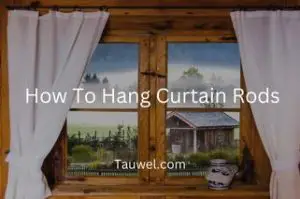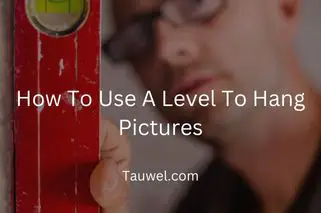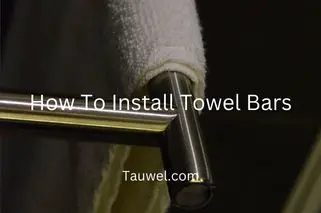This post contains affiliate links. Read the full disclosure here.
Curtains are one of the most essential parts of any house. Not only do they add aesthetic value to the house but they also help in blocking sunlight and giving privacy to the household. But installing curtains can seem like a daunting task for someone who hasn’t done it before. Doing it the wrong way can ruin your walls or make your curtains lopsided. Let’s take a look at a step by step guide to installing curtain rods.

After determining the height at which you want to install the rod, mark one point 5-6 inches (13 centimeters) away from the window edge at the required height. Use a spirit or laser level to determine the correct point on the opposite end. This will ensure that the rod is properly aligned. Then either use a tension rod or drill holes at the marked area to attach the rod brackets.
Contents
What Tools And Items Are Required?
Other than the curtains and rods themselves, you will need a drill and a drill bit along with the required screws. A ladder to help reach the required height and a ruler, pencil, spirit or laser level, stud finder, safety glasses, and wall anchors if required.
In a Hurry? Don’t go without checking this TRENDING Topic Out - 6 Best Towels For Blackstone Griddle In 2022 out
How To Install a Curtain Rod?
The first step is to determine where you want the curtain rod to start. With most windows, you have the option to choose from either installing the rod beginning at the window casing or outside of it.
If you choose to start from the casing, the curtains will not be able to completely block the sunlight and only your windows will be covered by the curtains. On the other hand, choosing to start from the wall will give you a wider area for the curtain to cover.
Once you have determined the correct height to install the rod, which is about 4-6 inches (11 centimeters) above the edge of the window. Mark a point at that height 4-6 inches (11 centimeters) away from the edge of the window.
So the first point will be 4-6 (11 centimeters) inches above and towards the side of the window. Mark this spot with a pencil. Now take a ruler, a level and a pencil to properly align the other point.
If you have not used a level before, you can read my article on how to hang a picture using a level. It goes into more detail on how to use a level or a laser level.
A laser level will be easier for this process as you can attach one at the first mark and appropriately mark the other point equidistant from the edge of the window.
If you are using a spirit level, attach a thread or rope at the first mark using painter’s tape and stretch it out to the other end, place the spirit level on top of the thread and once the bubble is at the center mark the other point.
Using an electric drill, at the marked points, make pilot holes for attaching the rod brackets. If there are no studs present in the area, use anchors. Place the brackets over the hole and screw in the screw using the drill or a screwdriver. You can use a stud finder to locate any studs in the area.
Attach the other bracket and place the curtain rod on it. Double check whether the curtain rod is properly aligned or not. Add the curtains to the rod and you are finished.
How To Install a Curtain Rod Without Drilling?
If you don’t want to go through the entire drilling process, there are tension rods available in the market. With tension rods you don’t have to use any of the mentioned tools. Simply follow the steps as specified in the specific product which usually involve loosening the edges of the rod and placing them in the desired position before tightening it again.
Tensions rods are strong and can usually hold any type of curtain. One downside is that they cannot be installed everywhere. Having a window casing or close by edges is a requirement. They might also damage plaster walls in some cases.
Tips For Installing Curtain Rods On Wood, Concrete or Plaster Walls
If you are dealing with plaster or concrete walls, you will need to use different drilling equipment to get the job done.
For plaster walls, use Molly screws which expand once they are inside the walls. For concrete walls, use masonry bits with the drill and plastic or metal anchors to add the required grip.
For plaster walls with studs, you can use 3 inch screws to ensure that the screw goes through the stud behind the wall.
Conclusion
Hanging curtain rods can go horribly wrong if it is lopsided at the end or if it just falls randomly. You can either use a tension rod or a normal curtain rod which requires drilling and using anchors. While the former is easier, it may not be suitable for every location and it will not have as much grip strength. It is important to use a level to make sure the drilling points are perfectly aligned.



